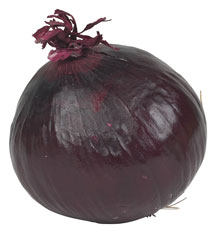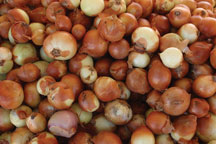Arts
The Onion Sutra

Warning: Do not separate an Indian from his onions!
|
It is the one ingredient that no self-respecting desi cook would want to be without. Whether you are making a Mughali feast or a frugal meal, onions are absolutely crucial. Onion shortages are known to have brought down governments in India. The rising prices of onions resulted in an electoral debacle for the ruling Bharatiya Janta Party in Rajasthan and Delhi in 1998. Last October as Prime Minister Manmohan Singh faced off with the Left Front over the U.S. India Nuclear Deal, a run on onion prices is among the factors that dissuaded him from calling a snap election. The portal Commodity Online noted, “Your daily staple of onions is putting the ruling Congress government virtually in tears these days.” A newspaper pointed out: “India consumes on an average 40 lakh tons of onion a year and the projected imports of around 13,000 tons, of which 3,000 tons has been sought by Delhi, would meet only a day’s demand.” Nor were massive imports from Iran the answer, because, according to shopkeepers, people wanted their pungent red Indian onions and not the little bland white ones available from Iran, Oman and Dubai. “Every time, the price of onions goes high, Delhi comes to a standstill because onions, potatoes and tomatoes are the backbone of Indian cooking,” says the noted chef Suvir Saran of Devi restaurant in New York and author of American Masala. Indians are passionate about their onions. But this tuber is rarely a star performer. It’s almost always a character artiste and sometimes just an extra, but it is the ingredient which gives the dish its punch, its pizzazz (any wonder it’s called piaz in Hindi!). Onions are the food equivalent of a feisty, over-the-top Amjad Khan in Sholay – essential to the action, but no hero like Amitabh Bachchan or Dharmendra! Be it a Mutton Biryani or Achari Aloo, onions are in the background, making the dish what it is. Occasionally, onions play a lead role, such as in onion bhajjias, in which the succulent, tangy sliced onions dipped in a batter of gram flour are deep fried into crisp fritters, to savor with mint chutney. More often than not, though, onions are invisible artistes – you don’t see them, but know the show holds up because of them. After all, what would bhel puri be without onions? Chole Bhature without rings of raw onion? Or Potato Rawa Dosa with the onions missing? Take away the onions from these delicacies, and it’s like a technicolor world has suddenly been washed out and turned black and white. Onions often are the Rodney Dangerfield – I don’t get no respect – of Indian cooking, but try imagining some of your favorite dishes without onions and you realize you’ve long taken this pungent vegetable for granted.
The onion is known by many names in India – ulli in Oriya, villi Telegu, erangayam in Tamil, eerulli in Malayalam, neerulli in Kanad, kanda in Marathi, dungli and kando in Gujarati and piaz in Hindi. According to Suraj Bhan Dahiya of Agriculture Journal, it is one of the oldest vegetables in India and is cultivated throughout the country. Maharashtra, Tamil Nadu, Bihar and Andhra Pradesh are the main onion-producing states with Nasik, the biggest onion market in the country generally controlling onion prices and supply. According to Dahiya, Indian onions run the gamut of colors and taste and varieties, including red, white and yellow globe, white Patna, large red, Patna red, Nasik red, Yagiri or Bellary red and Dhulia. The more exotic varieties are white Portugal, silver skin, Australian brown sweet Spanish, red Italian, California early red, yellow Bermuda, Ebenezer and mountain danvers. Dahiya says: “The white skinned varieties are mild and good flavored as compared with the red varieties that are relatively more pungent, but keep better owing to the presence of catrechol and protocatechic acid in the skin.” Mad as Indians are over onions, the country that boasts the highest per capita consumption of onions, surprisingly, is not India. That honor goes to Libya, which consumes 66.8 pounds of onions per person each year. According to the UN Food and Agriculture Organization (FAO), India is the world’s second largest producer of onions (China is first), followed by the United States, Turkey and Pakistan. Fresh onions are exported from India to many countries, including Bangladesh, Malaysia, UAE, Sri Lanka and Bahrain. In Egypt, onions can be traced back to 3500 B.C. and were so valued that they were buried along with the Pharaohs. In the Middle Ages in Europe onions were a staple for rich and poor, and were regarded as a cure for headaches and hair loss – and get this, they were also used in lieu of wedding gifts and rent! Hmmm, imagine if you could pay for that Manhattan studio apartment’s rent in onions? Indians have a love-hate relationship with onions. Some communities can’t do without onions and others won’t touch them with a 10-foot pole. The Chinese traveler Hiuen Tsang noted in his visits to India between 629 and 645 AD: “Onions and garlic are little known and few people eat them; if anyone uses them for food, they are expelled beyond the walls of the town.” T. Achaya in Indian Food: A Historical Companion notes that onions were not mentioned in Vedic literature till 2nd century B.C. and then as despised foods that were forbidden to those seeking an austere life. Ayurveda regards onions as rajasic and tamasic, leading to passion and ignorance, and not suitable for those trying to meditate and lead a pure life. Onions are also thought to be an aphrodisiac and so not suitable for those seeking spirituality. Many Vaishnavas, Buddhists and Jains steer away from onions while Punjabis, Sindhis and Delhiwallahs have an absolute passion for them. This infatuation can be credited to the rich cuisine of the Mughals, which used onions in many meat dishes and biryanis. One celebrated dish in which onions are key players is Do Piazza (twice fried onions), which has several chicken, mutton and vegetable varieties. “In this dish, it’s all about the onions,” says Saran. “My mother used to make this dish with matar and onions. It’s the most beautiful green pea curry that you can have. It’s all about the sweetness of the onion and the peas, and the acid and the sourness that comes from the tomatoes.” Punjabis use onions as a thickener, as the savory flavor. They contrast a dish’s sweetness by browning the onions, explains Saran. Non-Punjabis often use hing (asofotedia) to get the onion-garlic flavor of North Indian Punjabi curries. Indian dishes use poppy seeds, sesame seeds and ground spices to thicken the sauce base to emulate the effect of onions. Onions are certainly king in Punjabi and Sindhi cuisine. The kebabs and curries of North India and the onion laden mutton and chicken sail dishes of the Sindhis are legendary. The community can’t get enough of onions and even vegetarian dishes, like Sindhi sai bhaji (spinach and vegetable stew) or sail mani (rotis cooked in a mint sauce) use an ample supply of onions. Saran himself is a lover of onions: “To me there’s nothing more beautiful than crispy, cold crunchy red onions with some fresh lime and cayenne. It’s the most beautiful condiment, especially when served with chole bhature.” He points out that since Indian cuisine doesn’t have lettuce based salads, radish, tomatoes and cucumbers, along with crisp onion rings, serve as the ingredients of Indian salads to accompany spicy Indian meals. Asked if onions were commonly cooked in his Brahmin household, which often spurn the vegetable, Saran says, “Absolutely. We make sauces with onions and tomatoes – dum ka masala – but only in certain styles of cooking. Not every dish on the table has to have onions. We always knew the dishes with the onions were more flavorful and more fancy dishes and the simple dishes were made without onions. Still in a home where onions are used, the majority of the food is cooked without onions – that’s the paradox.” While onions are a mainstay in meat dishes, some vegetarian dishes are also greatly enhanced by onions. Saran recalls his mother’s rajma (kidney beans) with the onions bhunoed (sauted) very dark and enriched with tomatoes. Another royal dish, made by his Brahmin cook, Panditji, was called khilwan urad ki daal. It was cooked like a pullao, so each grain of the daal is separate and perfectly cooked, almost like rice itself. “It’s yellow with the addition of turmeric, but it’s sprinkled with deep fried, caramelized onions and to this day, it’s my favorite lentil ever,” recalls Saran. “When my father and I wanted the one dish which made us both smile, we’d ask my grandmother to tell Panditji to make this. It is phenomenal and even in America when I make it in my cooking class, my students just melt and have a breakdown because of that lentil dish!”
Happily for Indian Americans, America has a healthy supply of onions available in fresh, frozen, canned, pickled, and dehydrated forms. Onions come in three colors – yellow, red, and white. Approximately 87 percent of the crop is devoted to yellow onion production, with about 8 percent red onions and 5 percent white onions. Indian Americans are possibly the only community to buy their red onions in 10-lbs sacs and Indian grocery stores probably the only supermarkets to sell them in such large quantities. For the busy onion-addicts there are also bags of deep fried dehydrated onions from India and Pakistan: throw in a spoonful with tomatoes into a pot simmering on the stove and you instantly have thick onion gravy. According to the National Onion Association, yellow onions are full-flavored and are a reliable standby for cooking almost anything. Red onions, with their wonderful color, are a good choice for fresh uses or in grilling and char-broiling. White onions are the traditional onions used in classic Mexican cuisine. They have a golden color and sweet flavor when sautéed. The good news is that not only do onions taste great, but are actually good for you. In India as early as the sixth century B.C., the medical treatise Charaka-Sanhita noted that the onion was good for digestion, the heart, eyes and joints. The National Onion Association ticks of the many health benefits of onions: Onions are rich in powerful sulfur-containing compounds that are responsible for their pungent odors and for many of their health-promoting effects. They are rich in chromium, a trace mineral that helps cells respond to insulin, as well as vitamin C. Onions are supposed to be effective against the common cold, heart disease, diabetes and osteoporosis. They do contain anti-inflammatory, anti-cholesterol, anticancer, and antioxidant components, such as quercetin. Indians love their onion chutney, murabas, kachumbar and pickled onions. In fact, in the famous Moti Mahal restaurant in Old Delhi all the rich kebabs and tandoori foods are served with wonderful, tangy pink onions and the tradition continues in Indian restaurants worldwide. From the dishes of royals to those of the poor in small villages, the onion adds shine to the food. When villagers have nothing else, they fall back on an onion and a roti. Says Saran, “It’s called Mukhewali piaz – they punch and crack the onion with their fist as the oils and juices ooze out; they will take haree mirchi or green chili and a roti with it – and that’s their meal.” The hathwali roti is shaped by hand rather than a rolling pin. It is thick and filling and eaten with a red onion, punched and succulent, it has all the drama of a great meal. Onions may make you weep, but as addicts will agree, they are worth the tears.
|




